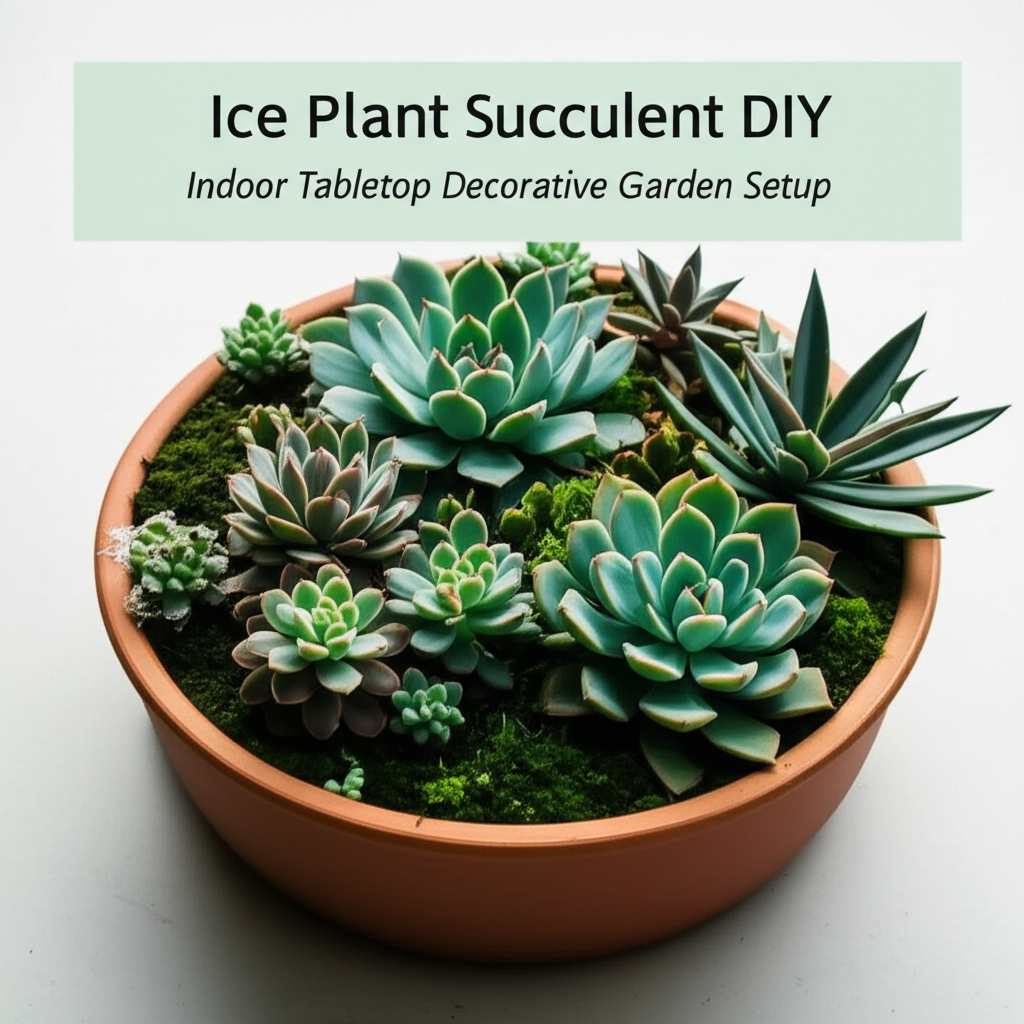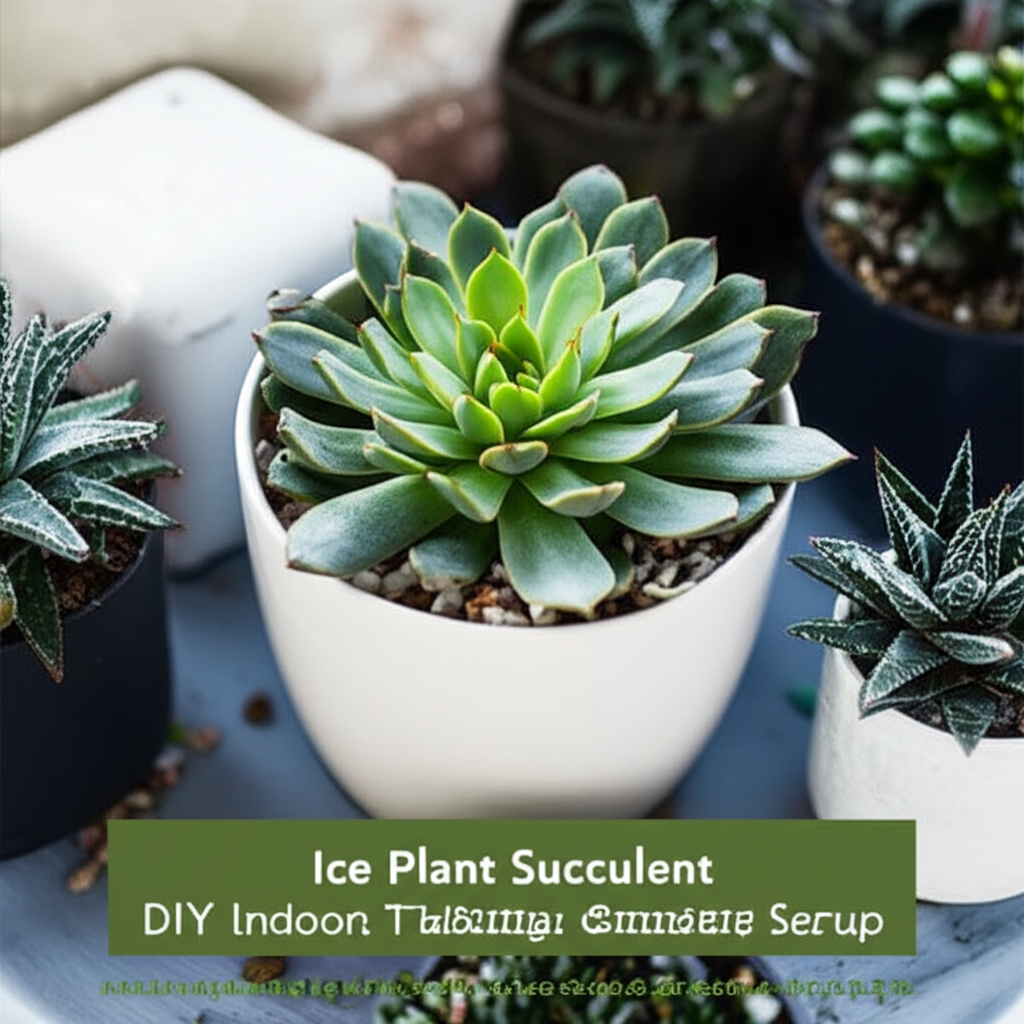Transform Your Space with a Dazzling Ice Plant Succulent Tabletop Garden
Bring the vibrant beauty and unique textures of the desert into your home with a DIY indoor tabletop garden featuring the captivating Ice Plant succulent. These remarkable plants, scientifically known as Mesembryanthemum crystallinum, are famed for their shimmering, crystalline epidermal cells that give them a frosted appearance, hence their common name. Perfect for adding a touch of modern elegance and a splash of color to any corner, an ice plant succulent garden is surprisingly easy to create and maintain, making it an ideal project for both beginner and experienced plant enthusiasts. This comprehensive guide will walk you through every step, from selecting the right plants and materials to designing and caring for your miniature desert landscape.
Why Choose Ice Plants for Your Indoor Garden?
Ice plants are more than just visually striking; they offer a range of benefits that make them excellent choices for indoor gardening:
- Unique Aesthetics: The distinctive crystalline structures catch the light, creating a mesmerizing, almost dew-kissed effect that is unparalleled in the succulent world.
- Drought Tolerance: Like most succulents, ice plants are adapted to arid environments, requiring infrequent watering and making them low-maintenance companions.
- Compact Growth: Many varieties remain relatively small and bushy, making them perfect for tabletop displays and smaller indoor spaces.
- Air Purification: While not as potent as some other houseplants, succulents can contribute to improving indoor air quality by absorbing certain toxins.
- Stress Relief: The act of creating and nurturing a garden, however small, is a proven method for reducing stress and promoting well-being.
Planning Your Ice Plant Tabletop Garden: Design and Materials

Before you dive into planting, thoughtful planning will ensure your ice plant garden is both beautiful and successful. Consider the aesthetic you want to achieve and gather the necessary supplies.
Choosing Your Ice Plant Varieties
While Mesembryanthemum crystallinum is the most well-known, there are numerous related species and cultivars within the Aizoaceae family that exhibit similar characteristics and are often referred to as “ice plants.” Researching specific varieties will help you select those best suited for your desired look and indoor conditions.
Popular Ice Plant Types to Consider:
- Mesembryanthemum crystallinum (Common Ice Plant): The classic choice, known for its prolific crystalline “ice” and often sprawling habit. Can produce delicate flowers.
- Delosperma cooperi (Hardy Ice Plant): While often grown outdoors, some varieties can thrive indoors and offer vibrant, daisy-like flowers in shades of magenta and pink.
- Livingstonia species (e.g., Livingstonia decipiens): These often have a more compact, clumping growth habit and can produce bright, colorful flowers.
- Conophytum species (Pebble Plants): While not true “ice plants,” some species within the Aizoaceae family share the characteristic of unique surface structures and are highly collectible for their miniature, stone-like appearance.
Selecting the Perfect Container
The container is as crucial as the plants themselves. It sets the stage for your miniature landscape and must provide adequate drainage.
Container Options:
- Shallow Ceramic Bowls: Ideal for creating a sense of a miniature desert landscape. Ensure they have drainage holes or consider using a layer of gravel at the bottom if drainage is limited (though direct drainage is always preferred).
- Terracotta Pots: Offer excellent breathability, which is beneficial for succulents, and have a natural, earthy aesthetic.
- Wooden Planters: Can add warmth and a rustic feel. Ensure they are treated for moisture resistance or line them with plastic to prevent rot.
- Repurposed Containers: Old bowls, trays, or even decorative tins can be transformed into unique planters, provided drainage is addressed.
Essential Growing Medium and Drainage Materials
Succulents, including ice plants, require a well-draining soil mix to prevent root rot.
Soil and Drainage Essentials:
- Cactus/Succulent Potting Mix: A commercially available mix is the easiest option.
- DIY Mix: Combine potting soil with perlite, coarse sand, or pumice in a 2:1 or 3:1 ratio.
- Gravel or Horticultural Grit: For the drainage layer at the bottom of the container if drainage holes are insufficient.
- Activated Charcoal: A thin layer can help filter impurities and keep the soil fresh.
Decorative Elements
To enhance the visual appeal and mimic a natural desert environment, consider these decorative touches:
- Various Sized Pebbles and Rocks: To create pathways, borders, or mimic rock formations.
- Sand: Different colors of decorative sand can add texture and visual interest.
- Small Driftwood Pieces: For a natural, weathered look.
- Miniature Figurines: To add a whimsical touch if desired.
Step-by-Step: Assembling Your Ice Plant Tabletop Garden
With your materials gathered and your design in mind, it’s time to get your hands dirty and bring your miniature oasis to life.
Step 1: Prepare the Container
Ensure your chosen container is clean and dry. If it doesn’t have pre-drilled drainage holes, you’ll need to create them. For ceramic or terracotta pots, a diamond drill bit designed for these materials is recommended. If creating holes isn’t feasible, add a substantial layer (at least 1-2 inches) of gravel or horticultural grit at the bottom.
Step 2: Create the Drainage Layer
Pour a layer of gravel or horticultural grit into the bottom of the container. This layer is crucial for allowing excess water to drain away from the plant roots, preventing waterlogging and rot. If you are using a container with ample drainage holes, this step might be less critical, but a thin layer can still be beneficial.
Step 3: Add the Growing Medium
Fill the container with your prepared cactus/succulent potting mix, leaving about an inch or two of space at the top. You can lightly compact the soil, but avoid pressing it down too firmly.
Step 4: Arrange Your Ice Plants
Gently remove your ice plants from their nursery pots. Loosen any tightly bound roots. Plan the arrangement of your plants within the container, considering their mature size and growth habits. Place taller plants towards the back or center, and trailing varieties towards the edges.
Step 5: Planting and Filling
Create small depressions in the soil for each plant. Place the ice plants in their desired positions and backfill with soil, ensuring the roots are covered. Gently firm the soil around the base of each plant.
Step 6: Add Decorative Elements
Now, unleash your creativity! Arrange pebbles, rocks, sand, and other decorative elements to create your desired landscape. You can create winding paths with small stones, use sand to fill in gaps, or place larger rocks to mimic natural outcrops.
Step 7: Initial Watering
After planting and decorating, give your new ice plant garden a light watering. Water the soil directly around the base of each plant, allowing excess water to drain out. Avoid saturating the soil, as the plants are still adjusting.
Key Facts and Comparison of Ice Plant Varieties
To help you make informed choices for your tabletop garden, here’s a comparison of some popular ice plant types.
| Variety | Scientific Name | Crystalline Appearance | Flower Color | Growth Habit | Light Requirements | Watering Needs |
|---|---|---|---|---|---|---|
| Common Ice Plant | Mesembryanthemum crystallinum | Pronounced, covers leaves and stems | White/Pale Pink | Sprawling, can be trailing | Full Sun to Partial Shade | Low – Allow soil to dry completely |
| Hardy Ice Plant | Delosperma cooperi | Less pronounced, more on leaf tips | Magenta/Pink/Purple | Low-growing, mat-forming | Full Sun | Low – Allow soil to dry completely |
| Livingstonia (e.g. decipiens) | Livingstonia spp. | Varies by species, often subtle | Yellow/Orange/Pink | Clumping, upright | Full Sun | Low – Allow soil to dry completely |
Caring for Your Indoor Ice Plant Succulent Garden
Maintaining your ice plant tabletop garden is straightforward, but understanding their specific needs will ensure their longevity and continued beauty.
Light Requirements
Ice plants thrive in bright light. Place your tabletop garden in a location that receives at least 6-8 hours of direct sunlight per day. A south-facing or west-facing window is typically ideal. If you don’t have enough natural light, consider using a grow light.
Watering
The most common mistake with succulents is overwatering. Ice plants are highly drought-tolerant. Water thoroughly only when the soil has completely dried out. You can test this by inserting your finger into the soil; if it feels dry an inch or two down, it’s time to water. Ensure good drainage to prevent water from sitting in the container. Reduce watering frequency significantly during the winter months when plant growth naturally slows.
Temperature and Humidity
Ice plants prefer warm temperatures, ideally between 65-75°F (18-24°C). They can tolerate slightly cooler temperatures, especially at night, but avoid prolonged exposure to frost or temperatures below 40°F (4°C). They do not require high humidity and generally prefer dry air, which is typical of most indoor environments.
Fertilizing
Ice plants are not heavy feeders. You can fertilize them sparingly during their active growing season (spring and summer) with a diluted cactus or succulent fertilizer. Apply once or twice during this period. Avoid fertilizing during their dormancy in fall and winter.
Pruning and Maintenance
As your ice plants grow, they may become leggy or overcrowded. You can prune them to maintain their shape and encourage bushier growth. Trim back any leggy stems or overgrown sections. These cuttings can often be propagated to create new plants. Remove any dead or yellowing leaves to keep the garden looking tidy.
Pest and Disease Management
Ice plants are generally resistant to pests and diseases, especially when grown in proper conditions. However, overwatering can lead to root rot, a fungal disease. Watch out for common succulent pests like mealybugs or spider mites. If you spot any, treat them promptly with insecticidal soap or neem oil.
Troubleshooting Common Issues
Even with the best care, occasional problems can arise. Here’s how to address them:
- Yellowing Leaves: Often a sign of overwatering or poor drainage.
- Mushy or Brown Stems: Indicates severe root rot, usually due to excessive moisture.
- Stretched or Leggy Growth: Suggests the plant is not receiving enough light and is reaching for it.
- No Crystalline “Ice”: This can be due to insufficient light or low temperatures during growth.
Pros and Cons of Ice Plant Succulent DIY Gardens
Like any gardening endeavor, there are advantages and disadvantages to creating and maintaining an ice plant tabletop garden.
| Pros | Cons |
|---|---|
| Unique and eye-catching aesthetic with crystalline structures. | Some varieties can be sensitive to overwatering, leading to root rot. |
| Low maintenance due to drought tolerance. | Requires bright light, which may be challenging in some indoor spaces. |
| Compact size makes them ideal for tabletops and smaller spaces. | Some species may have a sprawling habit that requires occasional pruning. |
| Can be propagated easily from cuttings. | Flower production can be sporadic and depends on optimal conditions. |
| The DIY process is creative and rewarding. | The crystalline effect can be diminished by excessive humidity. |
Conclusion: Your Miniature Desert Awaits
Creating an indoor ice plant succulent tabletop garden is a rewarding and enjoyable project that brings a touch of natural wonder into your home. With their unique shimmering beauty, low maintenance needs, and the satisfaction of a DIY creation, these captivating plants are sure to become a cherished addition to your living space. By following these guidelines, you can cultivate a thriving, miniature desert landscape that will be a constant source of delight and a testament to your green thumb. Enjoy the process of building your own serene and sparkling oasis!


